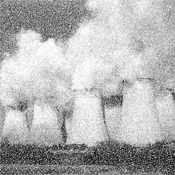People of conscience need to break their ties . . . it makes no sense to invest in companies that undermine our future.
—Desmond Tutu
The perpetuation of business as usual in the climate change era endangers the future of human existence and, consequently, imperils the realization of human rights.1 The recent signing and adoption of the Paris Agreement signifies a global consensus that climate change is an urgent threat and common concern of humankind that needs ambitious mitigation and adaptation efforts to solve the problem.2 The Agreement requires holding the increase in global temperature to well below 2°C while pursuing efforts to limit the temperature increase to 1.5°C above pre-industrial levels.3 The Paris Agreement is undergirded by principles of equity, common but differentiated responsibilities, sustainable development, and poverty eradication.4
Protecting the environment and eradicating poverty are an “indispensable requirement and integral part of achieving sustainable development.”5 Sustainable development incorporates three components: environmental protection, social development, and economic development. On January 1, 2016, the 17 Sustainable Development Goals of the 2030 Agenda for Sustainable Development officially became effective.6 The goals include women’s rights, eradicating poverty, climate action, food security, environmental protection, health, education, equality, and job opportunities.7 The Sustainable Development Goals promote equitable economic growth, equitable social development, and integrated and sustainable management of natural resources and ecosystems.8
Sustainable development is rooted in equitably meeting the developmental and environmental needs of present and future generations.9 This concept of intergenerational equity was first emphasized in the Stockholm Declaration preamble, stating that “[t]o defend and improve the human environment for present and future generations has become an imperative goal of humankind.”10 Furthermore, the United Nations Framework Convention on Climate Change (UNFCCC) requires countries to protect the climate system for the benefit of present and future generations of humankind on the basis of equity and in accordance with their common but differentiated responsibilities and respective capabilities.11
Viewing the scientific evidence and impacts of climate change through a human rights lens, climate change impacts endanger the effective enjoyment of a range of human rights. The connection between human rights and climate change has been recognized by the United Nations in a variety of documents by the Human Rights Council and the Office of the High Commissioner for Human Rights.12 In 2000, at the UNFCCC Sixth Conference of the Parties (COP6), the summit’s mission stated: “We affirm that climate change is a rights issue. It affects our livelihoods, our health, our children and our natural resources.”
The Mary Robinson Foundation is a leading climate justice organization that seeks to put justice and equity at the heart of climate change responses and identifies the strong connection between human rights and climate change.13 In its Principles of Climate Justice, the Foundation observed that “[c]limate justice links human rights and development to achieve a human-centered approach safeguarding the rights of the most vulnerable and sharing the burdens and benefits of climate change and its resolution equitably and fairly.”14 The climate “injustice” is that the people most vulnerable and marginalized are the ones that have had little to do with generating the greenhouse gas (GHG) emissions that cause climate change. Climate justice affirms the need to significantly reduce the emission of GHGs and associated local pollutants.15 The Bali Principles identified the 27 principles of climate justice.16
The business community is now recognizing this connection between human rights and climate change.17 Businesses play a role in addressing climate change impacts on human rights.18 Until recently, businesses addressed these two subjects independently of the other. Due to the growing awareness and recognition of the nexus between the two, however, businesses are now addressing climate change and human rights concerns holistically.19 Recent actions in the business and investment sectors reflect a new focus on protecting human rights in the face of climate change impacts.
This heightened awareness of climate change has inspired various institutional investors to divest from fossil fuels.20 Investors have embraced the same thinking by pushing for a new sustainable energy economy with socially and environmentally responsible investments.21 This fossil fuel divestment and investment in sustainable and socially responsible businesses will become a powerful driver of change.22 This transition will promote climate justice by taking a human-centered approach to climate change and safeguarding the rights of present and future generations in the investment decisionmaking process.
This chapter examines the ethical motivations behind the movement to divest from dirty energy in order to protect our planet and present and future generations. Part I of this chapter discusses the moral origins of the fossil fuel divestment movement, the litigation that has ensued, and the movement’s reach beyond its college campus origins. Part II identifies the sustainable business model through a corporate social responsibility (CSR) framework and discusses how CSR voluntary initiatives undertaken by companies can help promote climate justice. It addresses how climate change impacts are driving responsible investments and prompting investors to consider environmental, social, and governance criteria in the investment decisionmaking process.
The Fossil Fuel Divestment Movement
Movements seeking ecological equity for future generations and rights of nature have been gaining momentum in the 21st century.23 Divestment is a social responsibility campaign in which owners can decide to withhold their capital by selling investments in reprehensible activity.24 It is the process of removing investments that are unethical or morally ambiguous.25 Divesting is a form of social investing, defined as “the systematic incorporation of ethical values and objectives in the investment decision-making process.”26 The objective of divestment is to promote a certain behavior or policy.27
In the 20th century, reprehensible activity subject to divestment campaigns included tobacco, munitions, corporations in apartheid South Africa, adult services, and gaming.28 These divestment campaigns have been successful, but the largest and most impactful was the South African apartheid context.29 Divesting in multinationals doing business in South Africa helped break the back of the apartheid government and usher in a new era of democracy and equality.30 The success of this campaign is the inspiration for the current fossil fuel divestment movement.31
The fossil fuel divestment movement has quickly become the fastest growing divestment corporate campaign in history, surpassing the South Africa apartheid divestment movement.32 The spark began in August 2012 when Rolling Stone Magazine published an article by Bill McKibben, founder of the organization 350.org, which detailed the risk of increasing the global temperatures above 2°C.33 A tour called Do the Math was launched by 350.org explaining the need to limit the release of fossil fuels and keep the fossil fuels in the ground.34 The tour led to the 350.org Fossil Free Divesture Movement, “a network of independent campaigns petitioning institutions and investors to divest from fossil fuels.”35
The first major victory was in May 2014 when Stanford University agreed to divest its $18.7 billion endowment from coal companies.36 By December 2015, 500 institutions representing $3.4 trillion in assets committed to divesting.37
Moral Dimensions of the Fossil Fuel Divestment Movement
The fossil fuel divestment campaign focuses on the moral dimensions of climate change by spotlighting the immoral actions and impacts of the polluting fossil fuel industry.38 It is a climate justice initiative that seeks to stand in solidarity with vulnerable frontline communities and those already experiencing the impacts of climate change.39 The students of the campaign make a further plea that their futures are at stake because they are inheriting the consequences of global warming beyond 2°C.40 They emphasize the injustice in this reality because they did not create the crisis but have a responsibility to fix it.41 This intergenerational equity focus of the campaign seeks to ensure that future generations are not worse off by our choices.42 It requires utilizing resources sustainably to avoid irreversible damage to the environment.43
The movement focuses on “living up to our values, changing the business as usual mentality, and redefining our future.”44 Our values as humans are what determine how we will behave in certain situations.45 In order to have integrity, there must be consistency in what we say we value and what our actions say we value.46 Ethical decisions involve self-restraint: (1) not doing what you have the power to do and (2) not doing what you have the right to do.47
The goal of divesting from fossil fuels is to “diminish the influence and power of the fossil fuel industry in the market, our political system, and in the social conscience overall.”48 Fossil fuel divestment has three aims:
(i) “force the hand” of the fossil fuel companies and pressure government to leave the fossil fuels “down there”; (ii) pressure fossil fuel companies to undergo “transformative change” that can cause a drastic reduction in carbon emissions; [and] (iii) pressure governments to enact legislation such as a ban on further drilling or a carbon tax.49
It demands institutions and investors to eradicate the environmental and social injustices created by “dirty energy” by adopting sustainable investment policies.50
The Bali Principles on Climate Justice intended to shift “the discursive framework of climate change from a scientific-technical debate to one about ethics focused on human rights and justice.”51 “Divesting is a form of social investing . . . incorporating ethical values and objectives in the investment decision making process.”52 The campaign is not just to fight climate change “but to fight the racism, classism, and imperialism that the fossil fuel industries perpetuate.”53 This future generation is shifting the way of thinking “business as usual” and propelling change. This shift is necessary to change these social and political realities and have a meaningful response to climate change impacts on the environment and human rights.54
College Campus Future Generations Lead Divestment Campaigns
The Fossil Free Divestment Movement mobilized and trained thousands of students and young people to organize against the threats of climate change.55 Social movements use confrontational strategies, including media protests, to emphasize the negative social and environmental practices of highly visible corporations.56 With social media commanding the public’s attention, these corporations realize they are not immune to “naming and shaming” strategies when their valuable brands and reputation are linked to objectionable and social practices.57 Social movements have emerged as key forces in mobilizing political consumers to address their concerns through the market.58
The students are demanding full divestment of fossil fuels and are doing it in the name of “climate justice.” Students and graduates are making campaign pledges such as: “[M]illennials, we must rise to our historic moment and lead the call for climate justice. This is truly the fight of our lives.”; “[W]e will not stop until we confront, dismantle and ultimately transform oppressive structures that perpetuate climate injustice, gender violence, and economic equality”; and “[B]ecause I want a more just and sustainable world that protects humanity over profits, environment over exploitation.”59 The “fossil fuel divestment [movement] is a moral campaign at its core.”60 In an open publication, Divest Harvard students criticized the Harvard Management Company (HMC) for betraying its moral obligations to its students by investing new capital in oil and gas exploration and refusing to divest.61
Most of the divestments to which colleges, universities, or schools have committed are only partial, such as only divesting in coal or tar sands, and are mostly from smaller private colleges.62 Students are being advocates by writing and signing petitions, scheduling meetings, and conducting protests, week-long blockades, and sit-ins.63
Recently, this type of social activism generated real change on a university campus. On May 25, 2016, the University of Massachusetts became the first major public university to fully divest its endowment from fossil fuels.64 Divestment of coal at UMass first began last year in response to a petition from the Student Fossil Fuel Divestment Campaign at UMass.65 In April 2016, in efforts to call for full divestment of fossil fuels, the Campaign staged a series of protests that led to student arrests at UMass Amherst.66 This student activism resulted in a unanimous decision by the board of directors of the UMass Foundation to fully divest from fossil fuels.67 The board of trustees chairman stated that he will endorse the Foundation’s decision, “because members of the UMass community have urged us to consider divestment in moral terms . . . and we acknowledge the moral imperative.”68 The UMass Amherst chancellor stated in regards to the decision to divest, “[T]he Foundation’s action today . . . speaks volumes about our students’ passionate commitment to social justice and the environment. It is largely due to their advocacy that this important issue has received the attention that it deserves.”69
Although the divestment movement started on university campuses, it has spread beyond campuses and reached diverse institutions and cities throughout the world.70 Of the more than 500 institutions divesting, only 13% are universities, colleges, and schools.71 Other institutions divesting include faith-based organizations (26%), foundations (24%), governmental agencies (14%), pension funds (13%), nongovernmental organizations (6%), and for-profit corporations (3%).72
More than 70 cities worldwide have divested from fossil fuels, including Oslo, Norway; Paris, France; Newcastle, Australia; Muenster, Germany; Copenhagen, Denmark; San Francisco, California; Boulder, Colorado; and Minneapolis, Minnesota.73 In addition, Stockholm, Sweden, and Berlin, Germany, are reviewing their fossil fuel investments.74 Copenhagen’s mayor stated in his proposal to divest that it would be wrong to continue investing in fossil fuels when Copenhagen is leading the world in the transition to a green economy.75 Similarly, in deciding to divest from fossil fuels, the UMass board of trustees chairman shared a similar vision in stating, “[D]ivestment from fossil fuel companies is in keeping with our status as a national leader in environmental sustainability with cutting-edge programs in alternative energy research, sustainable agriculture, and sustainable built environment.”76 The decisionmakers deciding to divest are recognizing that their investments must align with their values to convey the proper message and uphold integrity in promoting their goals.
Fossil Fuel Divestment Litigation
Social activism in the fossil fuel divestment movement has been taken to the courts, as students demand climate justice.77 The litigation arose out of Harvard students’ frustration with the university’s refusal to divest from fossil fuels after demanding divestment from the university endowment through their campaigns and petitions.78 The students decided to take their advocacy to another level.
On November 19, 2014, the Harvard Climate Justice Coalition filed a complaint against the Harvard president and fellows of Harvard College, the HMC, and the attorney general of Massachusetts.79 The plaintiffs are a group of seven students, consisting of law, graduate, and undergraduate students.80 The students are bringing this suit seeking climate justice on behalf of future generations.81 The complaint names “individuals not yet born or too young to assert their rights but whose future health, safety, and welfare depend on slowing the pace of climate change.”82
The innovative causes of action listed in the complaint are twofold: (1) mismanagement of charitable funds and (2) intentional investment in abnormally dangerous activity.83 The statement of facts describes the vesting of responsibility in the “President and Fellows” by the charter of the Harvard Corporation to further the goals of “the advancement and education of youth.”84 They are suing the attorney general of Massachusetts by citing the duty of Massachusetts “‘legislatures and magistrates’ to ensure the charitable operation of schools . . . [by] acting in the public interest, furthering the education and welfare of the students, and refraining from actions known to cause harm to the public and students.”85
The lawsuit identified $79 million in direct holdings in publicly traded fossil fuel companies in Harvard’s endowment.86 The endowment also contains additional indirect holdings in fossil fuels, but the amount is not listed.87 The plaintiffs connect investing in fossil fuels with creating environmental and social harms because the universities are helping finance the fossil fuel industry’s business activities.88 The complaint identifies the catastrophic consequences that endanger the health, safety, and welfare of present and future generations if businesses continue to burn fossil fuels and emit GHGs.89The complaint is supported by significant evidence labeled as exhibits, including reports from scientists (James Hansen) and international organizations (the Intergovernmental Panel on Climate Change), federal agencies (U.S. Environmental Protection Agency), Harvard’s U.S. Securities and Exchange Commission (SEC) filing, Harvard’s charter, the Massachusetts Constitution, news articles, and academic studies.90
The mismanagement of charitable funds cause of action stems from Harvard Corporation’s breach of fiduciary and charitable duties as a public charity and nonprofit.91 The complaint asserts that investing in fossil fuels damages Harvard’s reputation, and the students’ and graduates’ reputations.92 The students are unable to be free of the threats of climate change, and the future damage to the university’s physical campus as a result of sea-level rise.93 The second count—intentional investment in abnormally dangerous activities—identifies the fossil fuel industries’ business activities as abnormally dangerous “because they inevitably contribute to climate change, causing serious harm to Plaintiff’s Future Generations’ persons and property.”94 The argument continues that there is no amount of reasonable care that can be taken by a fossil fuel company to substantially reduce the risk of harm.95 The complaint alleges that Harvard has knowledge or should have known that fossil fuel companies contribute to climate change and cause harm, and that these harms are well understood among institutions of higher education.96
The Harvard Climate Justice Coalition complaint requests “an injunction ordering Defendants to immediately withdraw Defendant Harvard Corporation’s direct holdings in fossil fuel companies and an injunction for Defendants to take immediate steps to begin withdrawing indirect holdings and to complete withdrawal within a reasonable period of time.”97 The plaintiffs also request a declaration that Harvard breached its obligations contained in its charter.98
The plaintiffs acknowledged the difficulty of meeting the “special interest” requirement to have standing to sue.99 The lawsuit was ultimately dismissed on the ground that the plaintiffs lacked standing because they claimed the threat was to “future generations.”100 The court reasoned that the plaintiffs’ status as Harvard students did not give them personal rights enough to have standing to charge Harvard with the mismanagement of its charitable assets.101
The Harvard students appealed the dismissal of the divestment lawsuit.102 The appellate brief was supported by amicus curiae briefs by Dr. James E. Hansen and the Animal Legal Defense Fund.103 The brief from the Animal Legal Defense Fund supported the moral obligation for the protection of future generations, as a recognized principle in international and domestic law.104 The city of Cambridge, Massachusetts, also supported the lawsuit.105 Dr. Hansen’s amicus brief also cites the moral obligation to protect future generations by phasing out fossil fuels.106 The appeal focuses on the same arguments that Harvard mismanaged its endowment by investing in “abnormally dangerous activities.”107 On June 7, 2016, the Harvard Climate Justice Coalition appeared for oral arguments in the Massachusetts Appeals Court and the appeal is pending as of this writing.108
Even in the face of this social activism and litigation, the HMC still decided not to divest but instead became the first university endowment in the United States to join the Principles for Responsible Investment (PRI) and the Carbon Disclosure Project (CDP).109 The HMC has dedicated a web page to their sustainable investments, reporting their focus on investments based on environmental, social, and governance (ESG) factors.110 The HMC assesses and manages ESG risks, and documents and considers risk before making a decision on the investment.111 The faculty members in support of divestment responded by saying that the PRI and CDP are “utterly ineffective.”112 These voluntary measures are not as effective in mitigating climate change as mandatory legal standards or full divestment; however, in lieu of full divestment, these initiatives can be seen as steps in the right direction toward a more sustainable future within businesses. If the intent behind the initiative is purely for public relations reasons, however, it would be deemed to be merely “greenwashing.”113 A sustainable business model “should not be a discretionary preference, to follow only if corporate leaders perceive an economic benefit.”114 What is necessary is the acceptance of an ethical responsibility to do what is right and act for environmental and social well-being, regardless of financial gain.115
Corporate Social Responsibility and Responsible Investment
Divestment of fossil fuels is promoting climate justice by bringing awareness to the moral obligation of corporations, wealth owners, and investors, and to the duty to protect the interest of society, future generations, and the environment. The campaign creates stigma and advocates for more socially responsible investment practices. Divestment of fossil fuels is the “people demanding institutions and corporations to adopt comprehensive sustainable investment policies that eliminate the environmental and social injustices that the fossil fuel industry is creating.”116 Climate justice will be achieved not just by divesting from fossil fuels, but also by businesses incorporating sustainable policies, practices, and standards into everyday business activities. Since divestment is the opposite of investment, sustainable and socially responsible investments are also needed to promote climate justice.
Achieving a sustainable future does not occur in a vacuum, however. Although often the primary source of environmental pollution, business must be part of the long-term solution.117 Compared to government, business has greater capital, research, development capacity, and influence in the market to push towards sustainable development and climate justice.118 The United Nations acknowledged the significant role of business in mitigating and adapting to climate change.119 Caring for Climate is a joint initiative convened by the United Nations Global Compact, the United Nations Environment Programme (UNEP), and UNFCCC and recognizes that “only through a critical mass of engaged companies can the private sector be an effective part of the climate solution.”120 The initiative calls on all companies to commit to corporate responsibility policies on climate action.121
Since the Earth Summit in 1992, the field of CSR has evolved to become part of mainstream thinking in corporate compliance with environmental and human rights principles.122 CSR is premised on the idea that businesses have a responsibility to society and all its stakeholders, not just to their shareholders or their bottom line profits.123 The World Business Council for Sustainable Development defines CSR as “the continuing commitment by business to behave ethically and contribute to economic development while improving the quality of life of the workforce and their families as well as of the local community and society at large.”124 CSR encompasses the sustainability agenda by thinking in terms of the “triple bottom line,” focusing on economic prosperity, environmental quality, and social justice.125 John Elkington wrote, “[t]o refuse the challenge implied by the triple bottom line is to risk extinction.”126 This shift in thinking for business priorities stems from a reshaping of society’s expectations.127
The severe financial crisis and climate change risks have underscored the need for businesses to incorporate ESG factors into their financial statements, policies, and disclosures.128 Businesses feel pressure from all stakeholders, customers, investors, financial institutions, and shareholders.129 Lenders and investors, of course, want the best return on their investments with the least amount of risks.130 Moreover, investors today understand that financial success and good corporate citizenship are connected.131
Therefore, investing in fossil fuels is a risky business not only because of the financial risks, but also because of the environmental and social risks. Al Gore made a comparison of the risks of investing in fossil fuels to the meltdown in the market for subprime mortgages: “The assumption that you can safely invest in assets that come from business models that assume carbon is free is an assumption that is about to go splat. Many companies have lots of assets in your portfolios that are chock full of ‘subprime’ carbon assets.”132
ESG issues have a material impact on those risks and fulfill fiduciary duties.133 These ESG practices and considerations are evident across the spectrum of business entities including financial institutions, institutional investors, individual investors, corporations engaging in CSR practices, and consumers. CSR and ESG performance, monitoring, and improvement provide the greater transparency that all sectors are demanding.134 After the financial crisis and the looming threat of climate change, consumers, investors, stakeholders, and suppliers are demanding greater transparency.135 This pressure caused an increase in CSR reporting to publicize companies’ ESG data.136
Corporate Social Responsibility Reporting and Disclosures
It is becoming the norm in corporate practice to submit sustainability reports or CSR reports using at least one voluntary initiative.137 CSR disclosure focuses on the paradigm of sustainability reporting, with the information reported being relative to the triple bottom line of social, environmental, and economic impacts of a corporation’s activities.138 Executives are now considering the environmental issues, such as climate change, to be among the most important issues affecting business.139 The Governance and Accountability Institute reported that in 2015, 75% of the Standard & Poor’s 500 Index produced sustainability reports, an increase from 20% in 2011.140
There are many voluntary initiatives and providers of CSR reporting, but the major providers offering sustainability reporting include: the Global Reporting Initiative (GRI) (GRI’s Sustainability Reporting Standards), the Organisation for Economic Co-operation and Development (OECD) (OECD Guidelines for Multinational Enterprises), the United Nations Global Compact (the Communication on Progress), the International Organization for Standardization (ISO) (ISO 26000, International Standard for social responsibility), and the Carbon Disclosure Project.141 The GRI is the best example of the CSR reporting trends.142 It was launched in 1997 by the Coalition for Environmentally Responsible Economies (CERES)143 and it included the participation of organizations such as CEP, UNEP, and the World Business Council for Sustainable Development.144 The GRI’s mission is “to elevate the comparability and credibility of sustainability reporting practices worldwide.”145 Currently, 92% of the 250 largest corporations in the world report on their sustainability performance utilizing the GRI.146 The GRI’s goal is to make sustainability reporting as commonplace as financial reporting.147
True sustainability reporting allows for greater transparency into corporate practices that either achieve CSR or impede its achievement. Sustainability reporting is valuable because it ensures that the organizations reporting consider their impacts on environmental and social issues and allows them to be transparent about the risks and opportunities that they encounter.148 A trusting relationship amongst stakeholders is necessary to receive good support.149 Transparency builds and maintains trust and credibility150 in businesses because it shows honesty, openness, and self-criticism.151 CSR reporting on ESG issues promotes better decisionmaking because it informs the decisions of investors, consumers, local communities, and civil society.152 Reporting in a transparent manner is an essential part of committing to sustainability.153
Businesses need to make sure that they report the good, the bad, and the ugly of their companies. Voluntary self-reporting can tempt companies to only reveal the greatest achievements and omit negative information.154 This type of reporting is seen as greenwashing and is only concerned with image and not with accurate reporting.155 This practice causes distrust in stakeholders because they fear a cover up and, therefore, are unable to be fully informed of the risks and benefits of the company.156 To avoid creating suspicion, companies should report achievements and weaknesses and identify the steps to fix the problems.157
International Voluntary ESG and CSR Initiatives
The growing public awareness of environmental performance is driving companies to adopt voluntary or self-imposed standards, guidelines, and codes.158Those supporting ESG and CSR considerations in any sector must rely on international voluntary corporate standards because transnational corporate activities are minimally governed by international law.159 These voluntary standards or initiatives usually do not have any verification methods or enforcement measures.160 The only enforcement mechanism available is to “name and shame” the companies that fail to meet these standards.161 These standards also lack explicit performance benchmarks.162 Some companies become signatories to these third-party initiatives committing to standards and codes of conducts to improve their public image.163 Others view these initiatives as attempts to prevent more stringent regulations through preemptive measures by the market.164 Others do it out of a commitment to true sustainability. Although there is no substitute for legally binding standards, these voluntary initiatives signify a change of consciousness, a change in values, a change in priorities, and a commitment across the globe to create a more sustainable and just future for our present and future generations in the face of climate change. The “business as usual” model is no longer mainstream, it is no longer popular, and the market has responded.
CSR voluntary corporate codes of conduct are becoming the norm as companies want to convey their core values and ethical business practices to all stakeholders. This shift in thinking to employ CSR has caused an increase in the majority of corporations dedicated to addressing larger social problems.165 The United Nations Global Compact is the world’s largest voluntary corporate sustainability initiative.166 More than 8,000 companies and 4,000 non-businesses have become signatories to the compact.167 The mission of the compact is for businesses to be responsible by aligning their strategies and operations with principles on human rights, labor, environment, and anti-corruption.168 The United Nations Global Compact’s General Assembly mandate is to “promote responsible business practices and UN values among the global business community and the UN System.”169
The 10 principles of the United Nations Global Compact are derived from the Universal Declaration of Human Rights, the International Labour Organization’s Declaration on Fundamental Principles and Rights at Work, the Rio Declaration on Environment and Development, and the United Nations Convention Against Corruption.170 The Compact principles have been endorsed by the Human Rights Council, which has confirmed the interconnectedness between climate change and human rights.171 The Global Compact institutes these principles as the core values to be shared among businesses, trade unions, and civil society.172 The United Nations Guiding Principles on Human Rights have been incorporated into the Compact commitments for the past four years.173 The Compact requires businesses to make a policy commitment to respect human rights and take proactive steps to prevent violations and remediate any adverse human rights impacts.174
Commitments to the Compact also include taking action to advance societal goals, such as the United Nations Sustainable Development Goals 2030.175 Through the Global Compact, businesses have played an important role in the process of shaping the Sustainable Development Goals and helping companies implement them.176 The efforts through partnerships created by the Compact include the Post-2015 Business Engagement Architecture, Rio+20 Corporate Sustainability Forum, Global Compact Local Networks, SDG Industry Matrix, Caring for Climate, and Global Compact LEAD.177
Opportunities for Responsible Investment
While CSR reporting has been on the rise within corporations, investors have been able to use this information to determine in which sectors of the stock market they want to invest. Socially responsible investing (SRI) is “an investment discipline that considers environmental, social, and governance (ESG) criteria to generate long-term competitive financial returns and positive societal impact.”178 The motivations for SRI investing include personal goals, institutional missions, and the demands of clients and stakeholders.179 Investors also are seeking strong financial performance in their investments to contribute to advancement in ESG practices.180 SRI allows investors to match financial investments with ethical and moral values.181 These SRI investments focus on considering ESG criteria.182 SRI investments were more than $6.57 trillion in 2014, a 76% increase compared to 2012 figures.183
The SRI practice used to focus on weeding out companies from specific industries that investors did not want to support, such as natural resource extraction and nuclear energy.184 This approach is a negative screen; positive screens focus on promoting positive change and rewarding good behavior by investing in companies that promote positive social and environmental impacts.185 This section discusses three important SRI opportunities to promote climate justice.
United Nations Principles for Responsible Investment: The United Nations Principles for Responsible Investment (PRI) is a voluntary set of guidelines for investors that seek to combine financial return with a moral and ethical obligation by giving consideration to the ESG issues of companies in which parties choose to invest.186 Ethical values are the essence of climate justice and instilling these principles into investment decisions allows for greater protection of the rights of vulnerable communities. The goal was to incorporate “ESG issues into mainstream investment decision-making and ownership practices.”187 This momentum is driven by recognizing that ESG factors play a material role in determining risk and return within the financial community.188 Investors understand that part of their fiduciary duty is incorporating ESG factors and that beneficiaries are demanding more transparency.189 Responsible investment is also grounded in the fact that companies could face serious reputational risk by destroying value on environmental (climate change and pollution), social (employee diversity and working conditions), and economic issues (aggressive tax strategies).190 The PRI has nearly 1,500 signatories that represent $60 trillion from more than 50 countries.191
Shareholder Resolutions; An important aspect of SRI is shareholder advocacy. Through shareholder resolutions, investors are given the opportunity to file resolutions to raise ESG issues.192 These resolutions involve human rights, working conditions, and climate change issues.193 In 2007, only 43 climate shareholder resolutions were filed with U.S. companies.194 That number increased in 2009, with 68 shareholder proposals on climate change.195 In the 2015 proxy season, a record-breaking 433 social and environmental shareholder resolutions were filed with climate change as one of the leading drivers of the uptick in activity.196 By filing shareholder resolutions, active shareholders are able to bring important issues to the attention of company management.197 Filing these resolutions gains media attention and educates the public.198 The mere process of filing resolutions prompts productive discussions and agreements, and the receipt of the shareholders’ majority vote further pressures action by the corporation’s management.199
Recently, an Exxon climate justice shareholder resolution, “Acknowledge Moral Imperative to Limit Global Warming to 2° Celsius,” was filed.200 It stated that the poor and most vulnerable are the first to suffer, while future generations, holding no responsibility, will live with greater impacts of global warming.201 Shareholders called on the board of directors to act by adopting a policy acknowledging the imperative to limit global average temperature increases to 2°C above pre-industrial levels.202 Exxon challenged the proposal as “vague” to exclude the climate justice proposal from this year’s proxy ballot so that the shareholders would not be allowed to vote, fearing a majority in favor of the resolution.203 The SEC reviewed the resolution and denied Exxon’s challenge.204 This outcome is a significant victory, as shareholders will have the opportunity to vote on Exxon’s moral responsibilities regarding climate change.205 These moral and ESG considerations are continuing to take center stage in the investment decisionmaking process in seeking to promote climate justice.
Equator Principles ESG Guidelines for Financial Institutions: This framework sets out minimum standards for institutions to implement to ensure due diligence in determining, assessing, and managing environmental and social risks when determining whether to finance projects.206 Financing of the project is conditioned on complying with the Equator Principles (EP). If companies will not or are unable to comply with the EP, then no project finance or project-related corporate loans will be provided.207 Borrowers must categorize and fully disclose environmental and social risks and provide a mitigation plan to manage the risks to obtain loans from these Equator Principles Financial Institutions (EPFIs).208
Currently, 83 EPFIs209 in 36 countries have adopted the EP.210 This number of institutions covers more than 70% of international project finance debt in emerging markets.211 The EPs incorporate principles of climate justice by including comprehensive standards for indigenous peoples and consultation with locally affected communities within the project.212 Borrowers must also disclose to affected communities “a mechanism for addressing grievances, and third-party verified review, monitoring, and annual public reporting.”213 Studies show that after the financial crisis of 2008, only four of the largest financial institutions—Bank of America, Wells Fargo, JP Morgan Chase, and Citibank—survived and they were all signatories to the EPs.214 This outcome is further proof that incorporating ESG principles into lending practices helps manage and identify risks and opportunities.
Conclusion
The impacts of climate change are the biggest threat of our time, imperiling both natural resources and human rights. This connection between climate change and human rights has significantly impacted decisionmaking in financial markets from divesting to investing. Companies, consumers, and investors are prioritizing ESG considerations and responsible business practices. The detrimental impacts of climate change have prompted the recognition that there is an ethical and moral obligation to invest responsibly by choosing to divest from morally reprehensible activities such as fossil fuel extraction.
These actions promote climate justice via the financial investment markets. Investors are recognizing not only the financial incentives of considering ESG factors, but most importantly the ethical need to invest in sustainable and socially responsible companies to protect the needs of present and future generations. Investors now understand and recognize climate change risks and social injustices and do not want to invest in or support companies that are not concerned with their moral duty to be good citizens of the world. The businesses that survive are the ones that have a genuine interest in caring about the people and the planet while also making a profit.
Divesting from fossil fuels and SRI reduces GHG emissions, helps eradicate poverty, promotes sustainability, and protects future generations. Although the actions undertaken are voluntary in nature, they represent an important shift in thinking necessary for a sustainable future. Therefore, these actions promote the goal of climate justice for the most vulnerable communities of the world. TEF
This chapter appears in Climate Justice: Case Studies in Global and Regional Governance Challenges, Randal S. Abate, editor. 700 pages. $79.95. The collection is published by ELI Press, the book publishing arm of the Environmental Law Institute.
Josephine Balzac is an assistant professor in the Department of Social Entrepreneurship at Rollins College.






